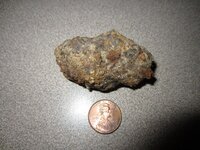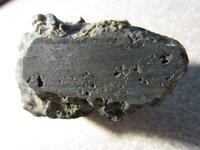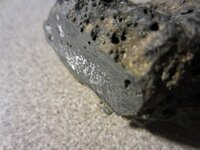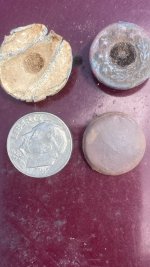Ism
Hero Member
- Jun 17, 2009
- 639
- 206
- Detector(s) used
-
Tesoro Vaquero
Whites TDI
Minelab Sovereign GT
XP Deus
- Primary Interest:
- All Treasure Hunting
I was out detecting and got a deep signal in the coin range. At about 12" I unearthed this nugget of iron from the earth. I dig my share of deep iron especially nails and flat washers. They give enough of an iffy signal that I can't pass them up for the chance that its a coin. Anyhow, they always have a thick patina of rust and pitting. This solid nugget has some rust but unlike most iron I've dug it doesn't look man made. It has sand and small pebbles fused into its surface as if it was dropped to the earth while super heated. It may be nothing but its the closest thing to a potential nickle/iron meteorite that I've found.

I took it to work and sandblasted the crust off of it and exposed a surface that showed pitting and what look like gas bubbles,a disapointment as meteorites don't have gas bubbles.
I then belt sanded a portion to expose the interior and found a marbled solid metal surrounded by a rocky/metallic substance. Upon further examination, the gas bubbles are actually natural formed cavities with a crystalline surface similar to a geode.


I know little to nothing about geogology and meteorites so I was wondering if this specimine can be identified. I haven't tested it for nickle because I'm not sure it is a meteorite anymore but am clueless as to what else it could be. It hasn't formed any rust on the metallic surface yet and it is magnetic.
Oh I did a streak test of the exposed surface and it leaves a light grey streak on the back of a tile. I have also seen some slag before and it doesn't look like any I've seen before. I showed a friend that worked in a steel foundry and he didn't ID it as slag either (although I didn't ask). However that doesn't mean it can't be.
Thanks,
Ran

I took it to work and sandblasted the crust off of it and exposed a surface that showed pitting and what look like gas bubbles,a disapointment as meteorites don't have gas bubbles.
I then belt sanded a portion to expose the interior and found a marbled solid metal surrounded by a rocky/metallic substance. Upon further examination, the gas bubbles are actually natural formed cavities with a crystalline surface similar to a geode.


I know little to nothing about geogology and meteorites so I was wondering if this specimine can be identified. I haven't tested it for nickle because I'm not sure it is a meteorite anymore but am clueless as to what else it could be. It hasn't formed any rust on the metallic surface yet and it is magnetic.
Oh I did a streak test of the exposed surface and it leaves a light grey streak on the back of a tile. I have also seen some slag before and it doesn't look like any I've seen before. I showed a friend that worked in a steel foundry and he didn't ID it as slag either (although I didn't ask). However that doesn't mean it can't be.
Thanks,
Ran
Last edited:



